Finding duplicates of reputed brands is a common affair. It takes a lot of time and effort to build customers’ trust and identify your products with them. So it makes it more worthwhile to protect your brand. Trademarks offer this protection as an intellectual property right. They protect a word, phrase, logo, or image through which your customers identify your business from others.
But, it is also essential to check if a trademark like the one you wish to register exists. You can conduct a trademark search in India by using wordmarks, Vienna code, or phonetic search. These are the various criteria on the public search of trademarks website. This article will discuss why and how to search for a trademark.
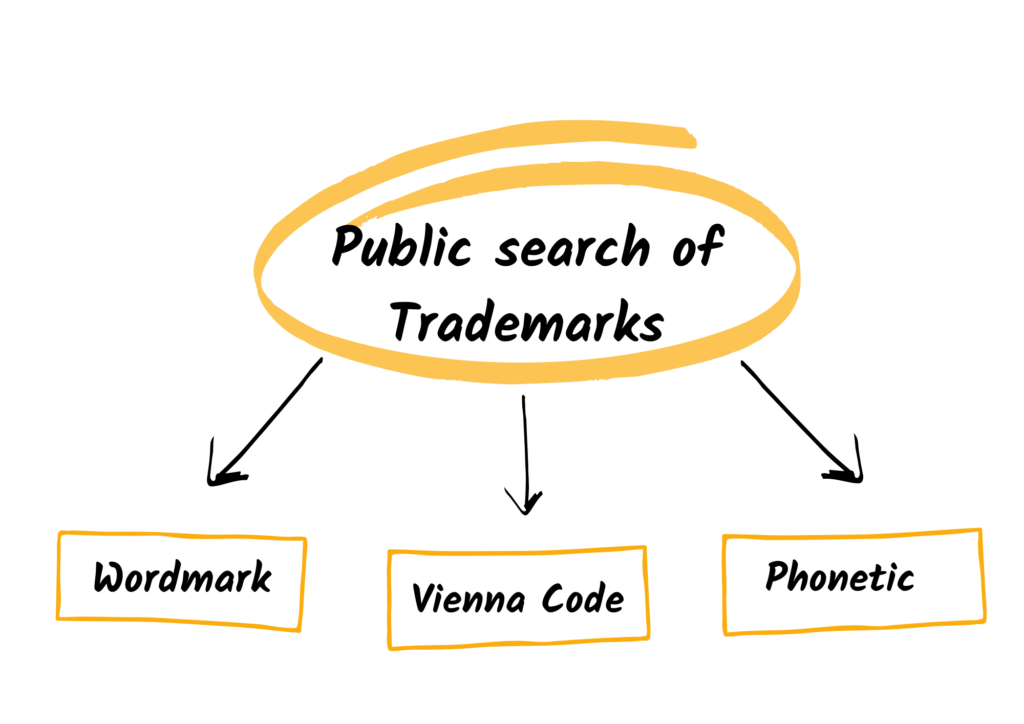
Why should you conduct a trademark search?
Before you register your trademark, the first step is to check for existing trademarks. The many reasons as follows will help you decide on searching for a trademark:
Check the availability of the trademark you wish to register
There are many applications for trademarks each year with the CGPDTM office in India. So your trademark must be unique and relatable for the consumer. But the effort and creativity in making a distinctive trademark can go in vain if your trademark is already registered. The office will raise objections if your trademark is like the one that exists already or is well known.
Save time and money from violating a registered trademark
There are many cases where businesses go into turmoil because of trademark violations. When you use an already registered trademark without permission from its owner, you infringe the trademark. If the owner finds you using their mark for similar goods or services, they can sue you. Besides, you might have to respond to objections, compensate for damages, or redesign your business. So prevention is better than cure. This search will help you avoid such cases and save time and money.
Check details of an already registered trademark
There may be cases when you already know of an existing, similar trademark. You can conduct a trademark search to check for details of already registered trademarks as well.
Check the category of goods and services that your trademark falls in
Classes for trademark registration are critical. So searching will show similar trademarks and their classes. This enables you to choose the type of goods to which your trademark belongs.
Catch potential infringers
This is how you can use trademark search to your advantage. You can also search for trademarks after you register your trademark. It helps you to catch someone using your trademark without permission.
How to search for trademarks in India?
Searching for a trademark is pretty easy. But it also needs skill and experience in determining the class to which your trademark belongs. This will help locate potential trademarks that are similar to yours. So you can search on your own or seek help from a Trademark agent.
Using the Indian Public Search of Trade Marks portal:
Trademarks can be words, phrases, designs, or logos (symbol). One can conduct searches depending on the type on the website using three criteria: wordmark, Vienna code, and phonetic search. We discuss these further here:
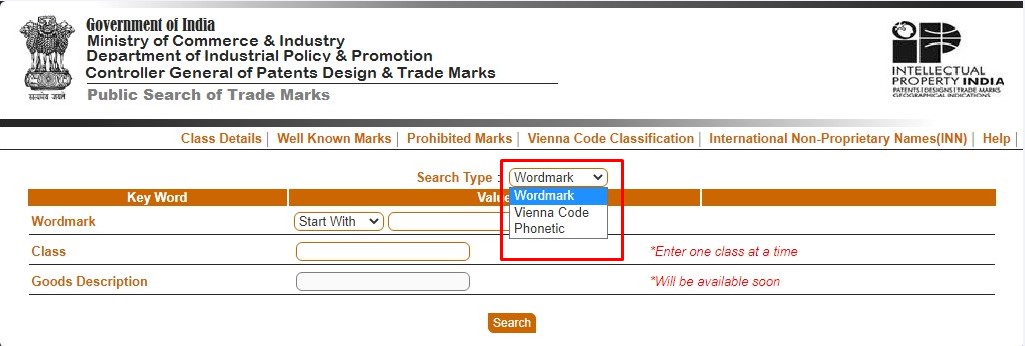
Wordmark Search
Wordmark is the name or term you use to develop the identity of your business. It is a text form of trademark. When you want to search for mark names similar to yours in writing, you can use the wordmark criteria. Google is the most remarkable example of a wordmark. Microsoft, the Government of Canada, Facebook are some other notable examples.
Since the basis of wordmark criteria is text, you can search using three options. These are
- Start With: Use this option to include results that start with the wordmark you enter. For example, if you use “Metro” at Start With, the results will show all wordmarks starting with “Metro,” such as Metropol, Metrol, etc.
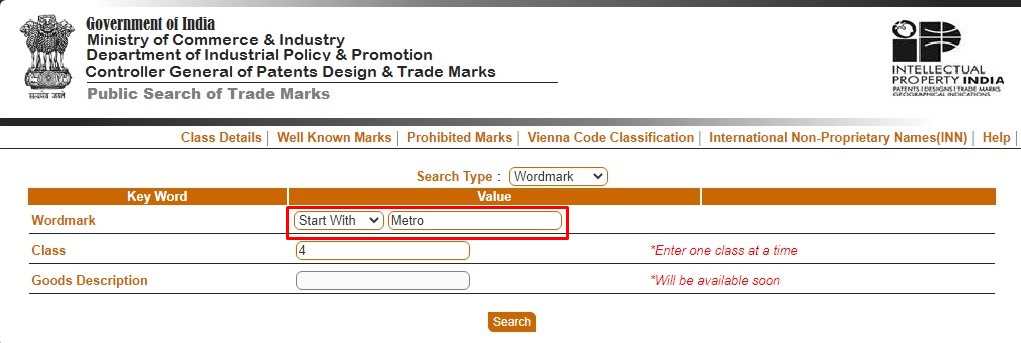
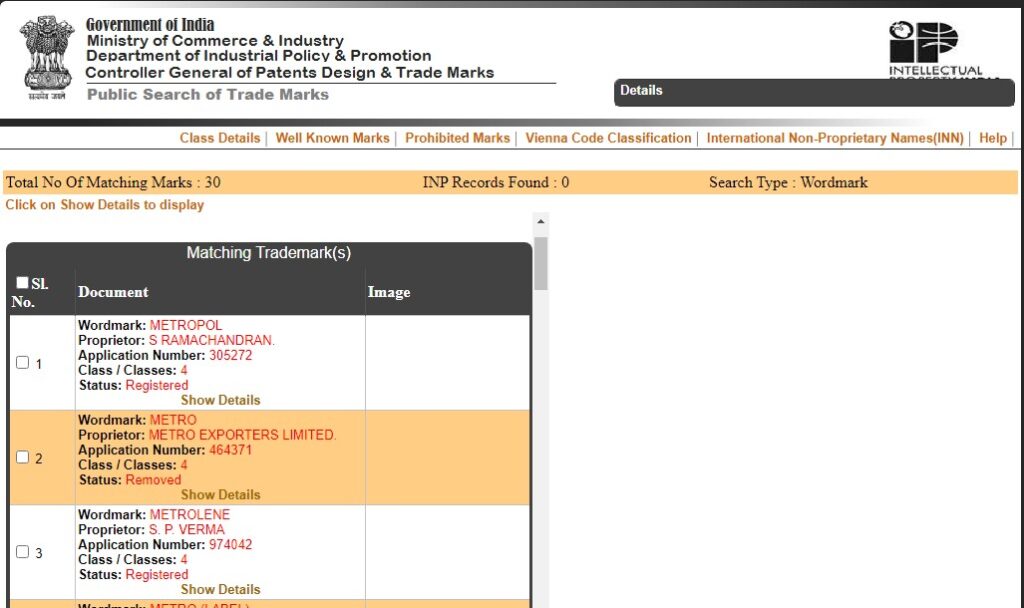
- Contains: Choose this option when you think that your wordmark occurs anywhere in a term. So if you use Metro in Contains, results will include KBA Metro, Quality Metro, etc.
- Match With: This option will return results with wordmarks that match the term you use. So using “Metro” in Match With will give results that are the same.
Class Search
It is mandatory to select the relevant class of the mark for any trademark search. Classification of trademarks is like arranged products in a supermarket. The supermarket categorizes products in different sections. We see groceries and beauty products placed in distinct areas and shelves. Similarly, classes group goods and services depending on the type.
How are goods and services classified?
The classification system used to group products is Nice classification. It is an international system to classify goods for the registration of marks. WIPO publishes a new version of each edition of the Nice class every year. There are 45 class headings in total that group goods and services into categories. Of these, 1-34 represent goods, and 35-45 represent services.
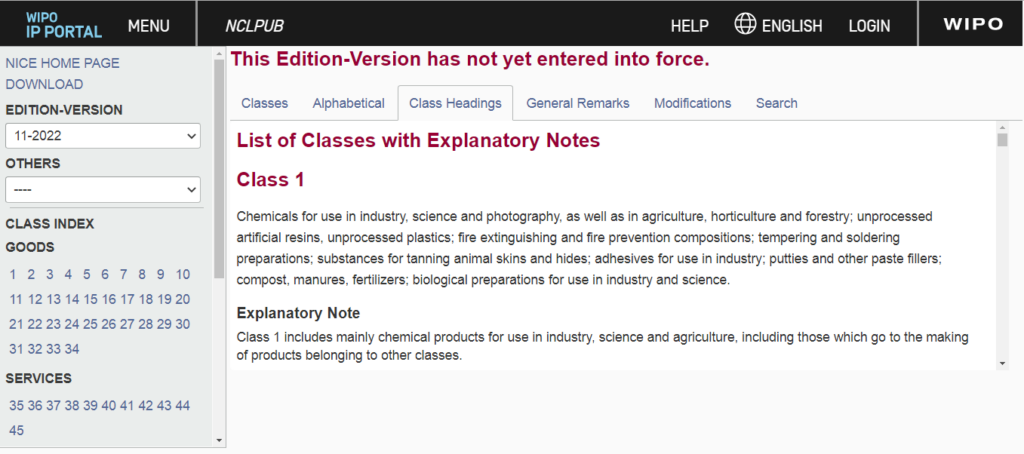
Vienna Code search
Broadly, trademarks may either have a word to identify the business or an image having specific features. Searching becomes tricky when the trademark is a device. The device can be an image, a logo, a design element, or a combination of the above.
Vienna code is an international system for the classification of device marks. It is the “Classification of the Figurative Elements of Marks.” You can use Vienna code search to find marks based on their visual features. Design elements (or device marks) are not words but depictions of an element of the trademark such as a bird, animal, star, etc.
But how does one classify how they look? The Vienna code classifies every element into 29 broad categories and narrows them down to a particular element to ease this process. It uses a 6-digit design code along with the class of the product. Vienna code works together with the class of products. Vienna code represents the symbolic aspect of the mark; class covers the type of goods of the trademark.
Let’s understand this with an example. You can access the table of categories under the Vienna code here.
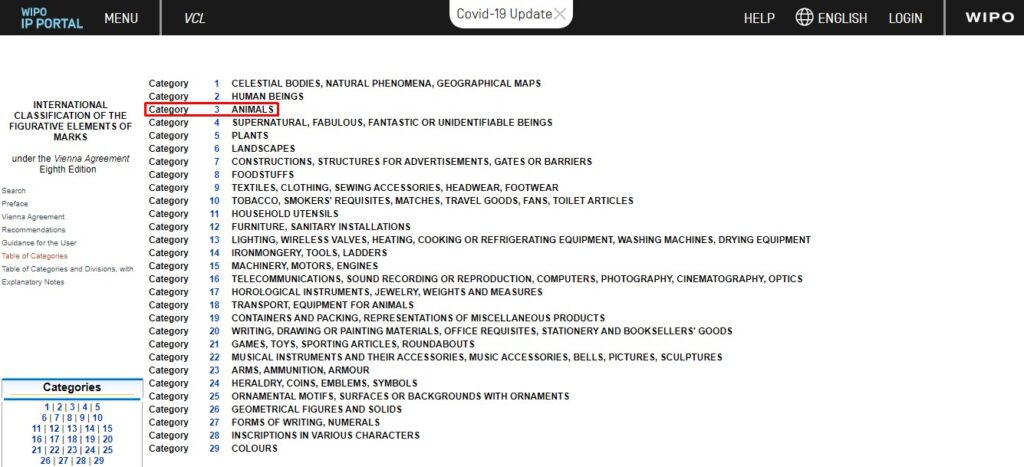
From this table, you can choose the broad category of a trademark. Let’s say you wish to trademark a logo with a leaping tiger for a shoe product. You will select category 3: Animals here. Check the categories which include your trademark. Let’s say you narrow this down to 3.1.4: “Tigers or other large felines.” Since the code must be 6-digit, we will use 030104 instead of 3.1.4 and 010117 instead of 1.1.17. Enter this 6 digit code in the Vienna Code and class 25 of the Nice class for shoes in the class section. This will return results having logos with feline animals.

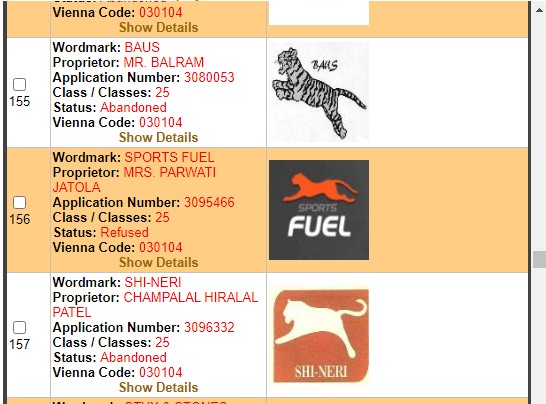
Phonetic search
Another option that the website provides is to search using the phonetics of your trademark. It uses similar ‘sounding’ words to search for registered trademarks. So if you wish to search for Para in phonetic search, the website returns results like Priya, PBR, Power, etc.
You must search thoroughly to reduce the chances of missing out on a relevant result. The phonetic search takes a little more time to generate a report or results than other searches.

Global brand database
Different countries have their databases for trademark registry. WIPO provides a collection of these databases in the global brand database. You can search for trademarks in the global brand database using Nice classification. Since it includes data from regional databases, it is not exactly a substitute but a backup search option. You should consider searching on this database after a thorough Indian search.
Key points to remember while searching for trademarks:
- Check each class of the trademark to which your product belongs. There can be more than one class of a trademark.
- Mentioning the class is mandatory.
- Also, conduct a general internet search to know if they exist in specific regions but are popular amongst locals. Any evidence that suggests confusion will lead to objections in your trademark application.
- Goods description on the public trademark search is not available at the time of publishing this article. Once it is, you must use it to narrow down the results relevant to your trademark.
Comprehensive trademark search through Trademark agents/firms
Professionals in the IP field use commercial databases to cover a broader range of trademarks. Trademark agents or attorneys may perform these searches for you. Besides the trademark databases, they might have access to other databases relating to companies and states.
Since these professionals are registered practitioners, they can give you a legal opinion of the search.
Conclusion
A prior search for existing trademarks is a handy tool to keep all bases covered. Business owners conduct these searches, especially when launching a new product line. When you run a thorough search, you can file for registration more confidently. Trademark examiners also go through the databases to conduct their investigation. While an IP professional can give you a legal clearance opinion, you should know of any existing trademarks similar to yours as well.
